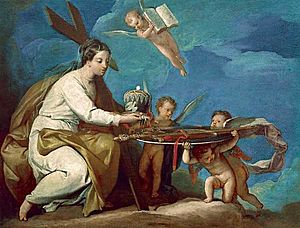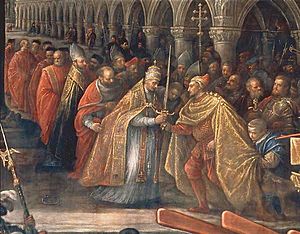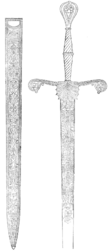Blessed sword and hat facts for kids
Quick facts for kids Blessed sword |
|
|---|---|
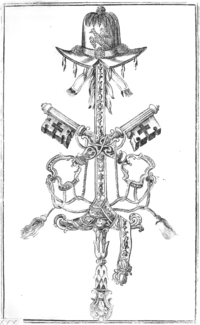
A blessed sword with a belt and a blessed hat received by Manuel Pinto da Fonseca in 1747, with the Keys of Heaven in the foreground
|
|
| Type | Ceremonial sword |
| Place of origin | |
| Service history | |
| In service | 14th–19th centuries |
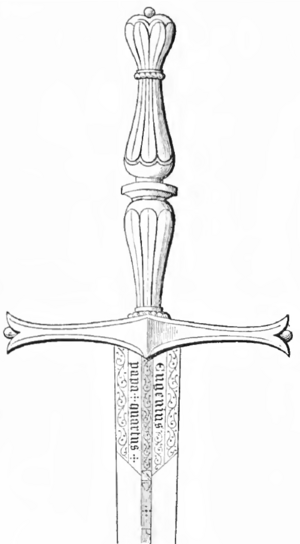
The blessed sword and the blessed hat were special gifts from popes. They were given to Catholic kings, queens, or other important leaders. These gifts showed thanks for protecting Christendom, which means Christian lands and beliefs.
Each sword and hat set was blessed by a pope on Christmas Eve in St. Peter's Basilica in Rome. The sword was a fancy, ceremonial weapon. It was often very long, sometimes up to 2 meters (about 6.5 feet). The handle had the pope's family symbol, and the blade had the pope's name. A matching decorated scabbard (sword cover) and belt came with it.
The hat was a tall, red velvet cylinder. It had two flaps hanging down from the top. On the right side, a dove made of pearls represented the Holy Spirit. A shining sun, symbolizing Christ, was embroidered in gold on the very top.
The oldest blessed sword we still have is in Madrid, Spain. Pope Eugene IV gave it to King John II of Castile in 1446. The newest one is in Paris, France. Pope Clement XIV blessed it in 1772 for Francisco Ximénez de Tejada, a leader of the Knights Hospitaller. Many important people received these gifts. This included emperors, kings of France, Poland, Spain, England, Scotland, Hungary, and Portugal. Other leaders like princes, dukes, and military commanders also received them. Even some cities and states got these special gifts.
Contents
History of the Blessed Gifts
The tradition of popes giving blessed swords and hats started a long time ago. It began at least in the 14th century. The first person we know for sure who received a sword and hat was Fortiguerra Fortiguerri in 1386. He was a leader from the Republic of Lucca. Pope Urban VI gave him the gifts.
However, records show payments for making these gifts as early as 1357. Some historians even think the tradition might be much older. They suggest it could go back to the 8th century.
From the early 1400s, popes kept detailed records of making these swords and hats every year. At first, popes gave them to nobles who visited Rome around Christmas. But over time, they started sending them to faraway rulers. This was a way to reward or encourage them. The gifts were meant to inspire leaders to defend Christian lands and the Catholic Church. This practice became more common under Pope Nicholas V (1447–1455). He used the gifts to help create a military alliance against the Ottoman Empire.
What the Gifts Looked Like
| Item | Cost |
|---|---|
| Blessed sword with scabbard and belt | |
| Blade (ready-made) | 3.00 ƒ |
| Wooden frame of the scabbard | 0.50 ƒ |
| Silver for the grip, pommel and decoration | 90.00 ƒ |
| Gilding (gold coating) | 20.00 ƒ |
| Red lining of the scabbard | 2.00 ƒ |
| Gold cloth for the belt | 15.00 ƒ |
| Silver for the belt clasp | 15.00 ƒ |
| Making the sword, scabbard and belt | 30.00 ƒ |
| Blessed hat | |
| Pearls | 35.00 ƒ |
| Ermine fur | 6.00 ƒ |
| Embroidery | 5.00 ƒ |
| Gold band | 5.00 ƒ |
| Making the hat | 4.00 ƒ |
| Total | 230.50 ƒ |
The blessed sword was always a two-handed sword. It could be over 2 meters (6.5 feet) long. The handle was made of silver and covered with detailed gold designs. The pommel (the end of the handle) had the pope's family symbol. It was surrounded by images of the papal crown and a special scarf called a pallium.
The blade had beautiful engravings. An inscription ran along the blade, showing the pope's name. It also showed the year of his time as pope when the sword was blessed. The scabbard and belt were just as fancy. They were covered in velvet and had precious stones. They also showed the pope's family symbol.
The sword never showed who received it. This was because the Church believed the pope was the true defender of the faith. The prince or king who got the sword was just the pope's "armed arm." The sword's meaning was linked to the pope's claim to both spiritual and worldly power. This idea came from the Bible story of Saint Peter using a sword to protect Jesus.
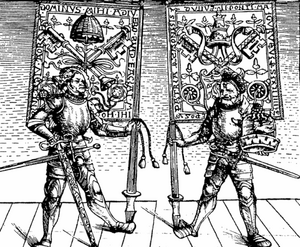
The hat was a tall, stiff cylinder with a deep brim. The brim curved up to a point at the front. Two flaps hung down at the back, like those on a bishop's hat. The hat was made of beaver fur or velvet. It was usually dark red, but sometimes gray or black. It was sometimes lined with ermine fur.
A dove with a halo, symbolizing the Holy Spirit, was embroidered in gold and pearls. It was on the right side of the hat. On top, a shining sun with straight and wavy rays was also made with gold thread. The dove meant the Holy Spirit would protect and guide the person wearing the hat. The dove and the sun (Christ) also reminded people of God becoming human. This is a special event celebrated at Christmas, the time when the pope blessed the sword and hat.
Ten blessed swords from the 15th century still exist today. About a dozen from the 16th century also remain. But sometimes, only the blade is left. The more valuable handle and scabbard might be missing. The hats were made of less strong materials. Even fewer of them have survived. The oldest hats are from the second half of the 16th century. We don't even know if the hat always came with the sword from the very beginning.
The Blessing Ceremony
Popes blessed the sword and hat every Christmas Eve. The blessing happened just before morning prayers. It was a simple ceremony. The pope would be in a private chapel or the church's sacristy (a room for sacred items).
The pope wore special white robes. He blessed both items, which a kneeling assistant held in front of him. He said a short prayer. Then, he sprinkled the sword and hat with holy water. He also used incense three times. After that, the pope put on a long red silk robe and went to the basilica (a large church).
If the person receiving the gift was there, they got it right away. The recipient wore a white robe over their regular clothes. They came before the pope. The pope would then read a short speech. This speech explained the meaning of the gift. It ended with words like:
- "[...] we name you, holy prince, as another sword of the Holy See. This beautiful gift shows that you are a very devoted son. And this hat shows that you are a strong protection and defense for the holy Roman Church against those who oppose the Faith. So, may your hand stay strong against the enemies of the Holy See and of Christ's name. May your right hand be raised, brave warrior, as you remove them from the earth. And may your head be protected by the Holy Spirit, shown by the pearly dove, in all things worthy by the Son of God, with the Father and the Holy Spirit. Amen."
The sword was then put on over the recipient's white robe. They were also dressed in a white cloak. The cloak was fastened on their right shoulder. This was so their arm was free to draw the sword later. The prince then kissed the pope's hand and slipper. This showed respect. With his new sword and hat, he joined the procession to the basilica.
During the morning prayers, the recipient sang a special part of the service. This part was about a conflict. Emperors had a different part to sing. Their part was about a census ordered by Emperor Augustus. Before singing, the prince took off his hat and gave it to his servant. Then, he took out the sword. He hit it against the ground three times. Then he waved it in the air three times. Finally, he put it back in its scabbard.
When the prayers ended, the recipient said goodbye to the pope. He returned to his home in Rome. A guard carried the blessed sword and hat in front of him. Cardinals, church leaders, and ambassadors followed behind.
If the person was not at the ceremony, the sword and hat were still blessed. They were then sent by a special messenger from the pope. The messenger would present them in a ceremony outside Rome. This ceremony followed a special set of rules. The messenger traveled with a small group. They carried the pope's letter to the recipient and a safe travel pass.
When the messenger was one day away, the recipient would send a group to meet them. The pope's letter was given to the prince. The prince then chose where and when the ceremony would happen. It usually took place on a Sunday or a major holiday. It was held in a cathedral or the main church in the town. A special mass was celebrated. During the mass, the pope's letter was read aloud. After that, the prince received the blessed sword and hat. When the ceremony was over, the recipient returned home in a procession, just like in Rome.
Who Received These Gifts
| Year Blessed | Year Given | Pope | Recipient | Notes |
|---|---|---|---|---|
| 1202 | Innocent III | William the Lion, king of Scots | Some historians question this | |
| 1204 | Innocent III | Peter II, king of Aragon | Some historians question this | |
| 1347 | 1347 | Clement VI | Charles IV, emperor of the Holy Roman Empire | Not certain |
| 1365 | 1365 | Urban V | Louis I, duke of Anjou | Given in person |
| 1366 | 1366 | Urban V | John I, count of Armagnac | Given in person |
| 1371 | 1371 | Gregory XI | Louis I, duke of Anjou (again) | Given in person |
| 1386 | 1386 | Urban VI | Fortiguerra Fortiguerri, a leader of the Republic of Lucca | |
| 1419 | Martin V | Charles, future King Charles VII of France | Not certain | |
| 1422 | Martin V | Louis III, king of Naples | ||
| 1432 | Eugene IV | Władysław II Jagiełło, king of Poland | Some historians question this | |
| 1434 | Eugene IV | Republic of Florence | ||
| 1443 | Eugene IV | Vladislaus III, king of Poland and Hungary | Probably lost in battle | |
| 1446 | Eugene IV | John II, king of Castile | Oldest preserved blessed sword, in Madrid, Spain | |
| 1449 | 1450 | Nicholas V | Francesco Foscari, leader of Venice | Blade preserved in Venice, Italy |
| 1450 | 1450 | Nicholas V | Albert VI, archduke of Austria | |
| 1454 | Nicholas V | Count of Sant'Angelo, ambassador of Naples | Given in person | |
| 1454 | 1455 | Nicholas V | Ludovico Bentivoglio, ambassador of Bologna | Sword and scabbard preserved in Bologna, Italy |
| 1456 | 1457 | Calixtus III | Charles VII, king of France | |
| 1457 | 1458 | Calixtus III | Henry IV, king of Castile | Blade preserved in Madrid, Spain |
| 1458 | 1459 | Pius II | Frederick III, emperor of the Holy Roman Empire | |
| 1459 | 1460 | Pius II | Albert III Achilles, margrave of Brandenburg-Ansbach | Given in person. Later became a special sword for Brandenburg. |
| 1460 | 1461 | Pius II | Philip the Good, duke of Burgundy | |
| 1461 | 1462 | Pius II | Louis XI, king of France | |
| 1462 | 1463 | Pius II | Cristoforo Moro, leader of Venice | Blade preserved in Venice, Italy |
| 1466 | 1466 | Pius II | Skanderbeg, lord of Albania | Given in person |
| 1467 or 1469 | Paul II | Henry IV, king of Castile | ||
| 1468 | 1468 | Paul II | Frederick III, emperor of the Holy Roman Empire | Given in person |
| 1470 | 1471 | Paul II | Matthias Corvinus, king of Hungary | |
| 1471 | Paul II | Borso d'Este, duke of Ferrara | Given in person | |
| 1474 | 1475 | Sixtus IV | Philibert I, duke of Savoy | |
| 1477 | 1477 | Sixtus IV | Alfonso, future King Alfonso II of Naples | Given in person |
| 1480 | 1480 | Sixtus IV | Federico da Montefeltro, duke of Urbino | |
| 1481 | 1482 | Sixtus IV | Edward IV, king of England | |
| 1482 | 1482 | Sixtus IV | Alfonso, future King Alfonso II of Naples (again) | Given in person |
| 1484 | 1484 | Innocent VIII | Francesco of Aragon, ambassador of Naples | Given in person |
| Between 1484 and 1492 | Innocent VIII | Ferdinand II, king of Aragon | ||
| 1486 | 1486 | Innocent VIII | Enea López de Mendoza, ambassador of Castile and Aragon | Given in person |
| 1488 | 1488 | Innocent VIII | Giovanni Giacomo Trivulzio, general of the church army | Given in person |
| 1491 | 1491 | Innocent VIII | William III, landgrave of Hesse | Given in person |
| 1492 | 1492 | Alexander VI | Frederick, crown prince of Naples (future King Frederick IV) | Given in person |
| 1493 | 1494 | Alexander VI | Maximilian I, king of the Romans | |
| 1494 | 1494 | Alexander VI | Ferdinand, duke of Calabria | Given in person |
| 1496 | 1497 | Alexander VI | Philip the Fair, archduke of Austria | |
| 1497 | 1497 | Alexander VI | Bogislaw X, duke of Pomerania | Given in person. Used as a symbol by later dukes. |
| 1498 | 1499 | Alexander VI | Louis XII, king of France | |
| 1500 | Alexander VI | Cesare Borgia, duke of Valentinois, pope's son | Sword and scabbard preserved | |
| 1501 | 1502 | Alexander VI | Alfonso d'Este, heir to the Duchy of Ferrara, pope's son-in-law | |
| 1506 | 1507 | Julius II | James IV, king of Scots | Later became the Scottish Sword of State, preserved in Edinburgh Castle, Scotland |
| 1508 | 1509 | Julius II | Vladislaus II, king of Bohemia and Hungary | Sword preserved in Budapest, Hungary |
| 1510 | 1511 | Julius II | Switzerland | Sword preserved in Zurich, Switzerland |
| 1513 | Leo X | Henry VIII, king of England | ||
| 1514 | Leo X | Manuel I, king of Portugal | ||
| 1515 | Leo X | Republic of Florence (again) | ||
| 1516 | Leo X | Francis I, king of France | Not certain | |
| 1517 | Leo X | Maximilian I, emperor of the Holy Roman Empire | Not certain | |
| 1525 | Clement VII | Sigismund I, king of Poland | Lost before 1669 | |
| 1529 | Clement VII | Charles V, emperor of the Holy Roman Empire | Blade preserved in Madrid, Spain | |
| 1536 | 1537 | Paul III | James V, king of Scots | Lost between 1542 and 1556 |
| 1540 | Paul III | Sigismund II Augustus, king of Poland | Lost after 1795 | |
| 1550 | Paul III | Philip, future King Philip II of Spain | Blade preserved in Madrid, Spain | |
| 1555 | 1558 | Paul IV | Ercole II d'Este, duke of Ferrara | Sword preserved in Benešov, Czech Republic |
| 1560 | Pius IV | Philip II, king of Spain (again) | Blade preserved in Madrid, Spain | |
| 1563 | Pius IV | Carlos, prince of Asturias | Blade preserved in Madrid, Spain | |
| 1566 | Pius V | Fernando Álvarez de Toledo y Pimentel, 3rd Duke of Alba | Blade preserved (location unknown) | |
| 1567 | 1568 | Pius V | Ferdinand II, archduke of Further Austria | Sword and hat preserved |
| 1580 | Gregory XIII | Stephen Báthory, king of Poland | Blade preserved in Kraków, Poland | |
| 1581 | 1582 | Gregory XIII | Ferdinand II, archduke of Further Austria (again) | Sword and hat preserved in Vienna, Austria |
| 1585 | 1586 | Sixtus V | Alessandro Farnese, Duke of Parma and Piacenza | Lost |
| 1591 | Gregory XIV | Philip, future King Philip III of Spain | Blade preserved in Madrid, Spain | |
| 1594 | Clement VII | Philip II, king of Spain (again) | Blade preserved in Madrid, Spain | |
| 1618 | Paul V | Philip, future King Philip IV of Spain | ||
| 1625 | Urban VIII | Vladislaus Sigismund, crown prince of Poland (future King Vladislaus IV) | Given in person. Blade preserved in Sweden. | |
| 1672 | Clement X | Michael Korybut Wiśniowiecki, king of Poland | Lost after 1673 | |
| 1674 | 1683 | Clement X | John III Sobieski, king of Poland | Sent by Innocent XI. Sword used for a coronation in 1829. Blade, scabbard and hat preserved in Kraków, Poland |
| 1689 | 1690 | Alexander VIII | Francesco Morosini, leader of Venice | Sword, scabbard and belt preserved in Venice, Italy |
| 1726 | Benedict XIII | Frederick Augustus, crown prince of Poland (future King Augustus III) | Scabbard, belt and hat preserved in Germany | |
| 1747 | Benedict XIV | Manuel Pinto da Fonseca, grand master of the Knights Hospitaller | ||
| 1772 | 1773 or 1775 | Clement XIV | Francisco Ximénez de Tejada, grand master of the Knights Hospitaller | Sent by Pius VI. Latest preserved blessed sword, in Paris, France |
| 1823 | Leo XII | Louis Antoine, duke of Angoulême |
See also
 In Spanish: Estoque y capelo bendito para niños
In Spanish: Estoque y capelo bendito para niños
- Golden Rose
- List of ecclesiastical decorations


